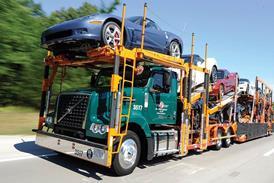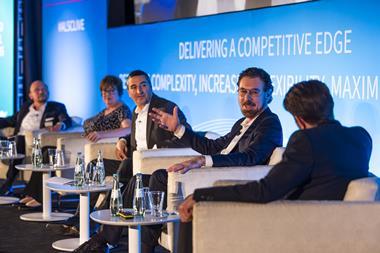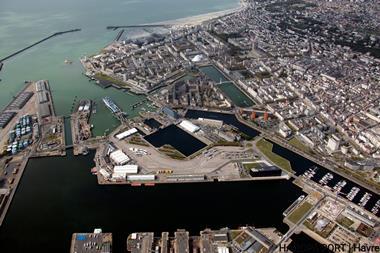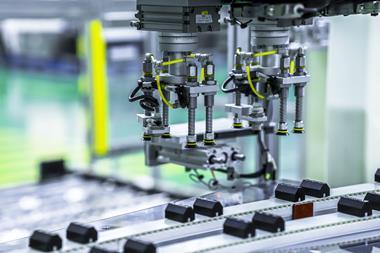Reaching the end of the Automotive Logistics conference in Shanghai, a senior executive panel joined editor Christopher Ludwig and publisher Louis Yiakoumi in a lively debate about some of the recurring themes from the event. Topics discussed included the impact the ‘One Belt, One Road’ initiative would have on the automotive logistics industry, the ongoing issue surrounding quantity over quality, and whether the Chinese government is close to finalising standards on truck lengths, and what impacts these could potentially have.
The panel featured Xu Guangqing, logistics engineering and operation management director, Shanghai GM; Ma Zengrong, executive vice-president, China Automotive Logistics Association of CFLP; and Jack Huang, director, supplier development, MRO purchasing and logistics, Magna International China.
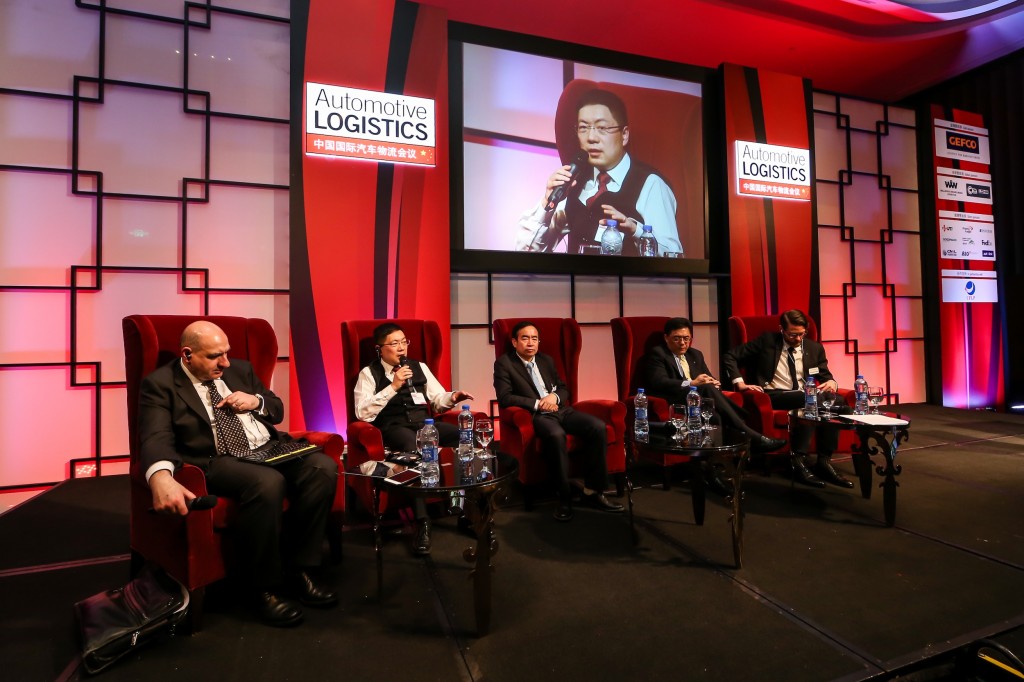
In China, the government is reforming the economy and wants to see more ‘quality’ as opposed to only ‘quantity’. How relevant is that today to the automotive logistics industry?
 Jack Huang, Magna:
Jack Huang, Magna:
As a tier one supplier we’re in the middle. Magna is a supplier, and we will always look at the best way to manufacture. People probably know we even manufacture cars in Graz, Austria. One of the most famous is the BMW Mini Countryman.
We want to work with our logistics partners. We are not experts at shipping parts. We make parts and rely on the experts to get them from point A to point B. We will of course look at the cost, but the cheapest is not always best and most efficient.
In the earlier discussion about the development of the railroads, my message is that we want more options. Most of the time, the only option is a truck. If there’s a railroad option available, obviously we’ll take it.
 Xu Guangqing, Shanghai GM:
Xu Guangqing, Shanghai GM:
China’s economy is slowly and steadily growing, and unlike in the past, the automotive industry probably won’t have the luxury of fast growth. I think that we also face a lot of cost considerations. Many clients require our cars to be sold at a cheaper price. In our purchasing, the price cut required each year is 10%, so eventually those cost savings would have to be absorbed by automotive parts manufacturers, and eventually logistics would have to take a cut as well. Logistics, service providers, shipping companies will all face challenges. Eventually we will not be able to win even through quality alone, and will need to innovate.
These companies will have to start to grow in their way of thinking. Over the past few years, innovation has been inadequate.
 Ma Zengrong, CFLP:
Ma Zengrong, CFLP:
The Chinese government is maintaining GDP growth at around 7% per year and this will probably be the number for the next few years. China’s economy is not going to come to a halt because we prioritise restructuring. Improving quality and quantity should go hand in hand and not conflict with each other. The cost is down 10% every year, and logistics has to be part of that, and it is one of the potential cost saving areas. However, the growth of automotive logistics is not shrinking in scale because of price or cost cutting.
We’ve grown more than 10% each year in the automotive market and automotive logistics has grown across the whole of the supply chain. I think that we now need to find new engines of growth for the automotive industry. Over the past 10 years of development we have come a long way. Companies such as Anji, Changan Minsheng and Beijing Changjiu Logistics had very humble beginnings. Ten years ago, we were not that good at what we do. But now, those companies are able to compete and provide services at a level similar to the world’s largest logistics providers.
Chinese logistics companies are not only serving foreign companies bringing their products to China, but they’re also serving domestic companies going international.
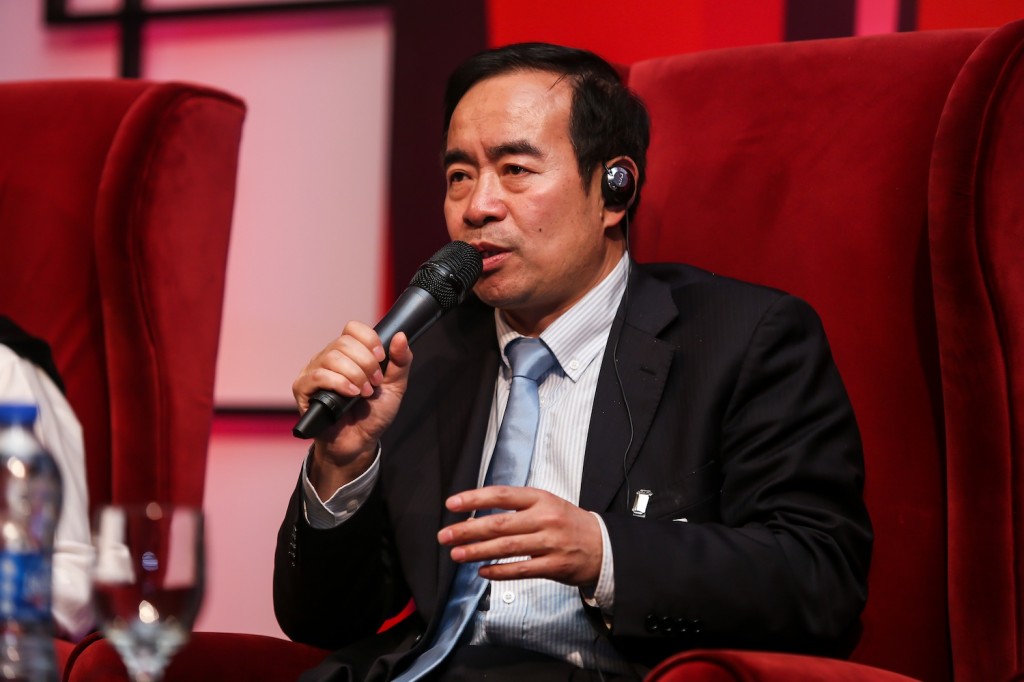 Ma Zengrong, executive vice-president, China Automotive Logistics Association of CFLP.
Ma Zengrong, executive vice-president, China Automotive Logistics Association of CFLP.E-commerce in particular is developing even better than it is in the US or the West, and we need to make sure volume and quality keeps improving. Being open is a key to success. When we look at the US, Europe, and China, these are the three key markets that are really open. We should be open to different ideas, embrace the global market, and there will be many opportunities to come.
Are logistics companies providing the right services?
 Xu Guangqing, Shanghai GM: This question came up last year as well. While many of you work for multi-nationals, some of you are local too. Some foreign companies find it hard to adapt to the local environment, but some domestic companies don’t know how to improve. Whether you’re local or foreign, identify the needs of your customers. What are the specific requirements? I come from GM, we have our specifics, and other OEMs would have completely different requirements because of their model. Each is different, unique, and difficult to replicate.
Xu Guangqing, Shanghai GM: This question came up last year as well. While many of you work for multi-nationals, some of you are local too. Some foreign companies find it hard to adapt to the local environment, but some domestic companies don’t know how to improve. Whether you’re local or foreign, identify the needs of your customers. What are the specific requirements? I come from GM, we have our specifics, and other OEMs would have completely different requirements because of their model. Each is different, unique, and difficult to replicate.Even logistics companies would have different models for their customers. A logistics model for my company would be different from Ford. You need to identify differences and act accordingly. This won’t take one or two days, but is a long and in-depth process.
Automotive manufacturers want logistics companies to work as strategic partners. It’s a long-term deal so both get to know each other well, learn the advantages of both companies, and learn the needs. There needs to be synergy where we can innovate and have the competitive competence.
Logistics companies would be able to contribute cost savings and efficiencies if they knew companies better. Some think they know more than they actually do, and consequently, services are not as good as they should be. Get to know your clients better.
 Jack Huang, Magna: You mentioned communication many times. Communication is important. From a tier supplier’s point of view, it’s even more complicated than for OEMs. I don’t have the leverage of GM, but I have a lot more pressure. Use the global logistics companies to your advantage, and work with some of the local companies too. You guys can figure out the way to work in China. A customer can tell you what they want, but they can’t tell you how.
Jack Huang, Magna: You mentioned communication many times. Communication is important. From a tier supplier’s point of view, it’s even more complicated than for OEMs. I don’t have the leverage of GM, but I have a lot more pressure. Use the global logistics companies to your advantage, and work with some of the local companies too. You guys can figure out the way to work in China. A customer can tell you what they want, but they can’t tell you how.What innovation would you like to see, or would you rather have standardisation first?
 Ma Zengrong, CFLP: The government recently hosted a meeting on standardisation, and is going to update many of the existing standards in China. We have national level standards – which include mandatory standards and optional standards – and there’s also industry standards and local standards.
Ma Zengrong, CFLP: The government recently hosted a meeting on standardisation, and is going to update many of the existing standards in China. We have national level standards – which include mandatory standards and optional standards – and there’s also industry standards and local standards.
In the future, environmental agencies, safety agencies, and those relating to peoples’ livelihoods will also issue mandatory standards. And we also have association standards.
Automotive logistics will also see new standards coming out. There are many mandatory standards that are not implemented, which leads to confusion in the market.
I believe we’ll see some adjustments at the national level. We will give a recommendation to the government as to which standards should be national, industry, and which are in conflict. This is part of the government transforming itself into a government that focuses more on serving the people.
The new car carrier measurements are still under discussion also. We could ship two more cars with a 22 metre-long car carrier, and 20 metres would put us on a par with our European counterparts. We have also agreed on a transition policy, which allow the industry 2-3 years to retrofit or phase out non-compliant equipment. However, the regulations have not been finalised yet, and probably won’t come out until the end of 2015 at the earliest. After the standards are unveiled it will have an impact on the logistics industry and there will be stricter regulations against lawbreakers. If a major accident happened, the rules may come in sooner. But if not, we might expect them for 2016.
 Xu Guangqing, Shanghai GM: In the logistics industry we see limited innovation. People are conservative and there’s still room for profit, so we are not forced to carry out innovation. Technology is not yet mature enough: people have not really heard of things like ‘Industry 4.0’, for example, so they just follow the wave. Going forward, there are two kinds of innovation. One is a model innovation, and to transform the operation, we have to think outside the box. Most OEMs ship different parts separately, but perhaps in future there will be a more integrated solution where parts are shipped with things like refrigerators, for example.
Xu Guangqing, Shanghai GM: In the logistics industry we see limited innovation. People are conservative and there’s still room for profit, so we are not forced to carry out innovation. Technology is not yet mature enough: people have not really heard of things like ‘Industry 4.0’, for example, so they just follow the wave. Going forward, there are two kinds of innovation. One is a model innovation, and to transform the operation, we have to think outside the box. Most OEMs ship different parts separately, but perhaps in future there will be a more integrated solution where parts are shipped with things like refrigerators, for example.
The second category is technical innovation. Some things are mature, like RFID, which has established standards and a reasonable price. Will that foster innovation?
We have to define where our core competitiveness is. For logistics companies, where is the point where you make a profit? Is it in traditional shipping? The model is moving away from using the traditional waterways, but establishing a network that covers a whole country or region. And with this network, you can outsource to 3PLs.
For many years it seems that we have been close to establishing truck standards. How confident are you that they will really be achieved this time?
 Ma Zengrong, CFLP: In the past few years the industry associations have been following the developments closely, and honestly we are nervous to see the standards when they come out. I think the standards will be unveiled next year. Once they are out, we will have to reach out to major companies to retrofit the existing vehicles that are not up to standard.
Ma Zengrong, CFLP: In the past few years the industry associations have been following the developments closely, and honestly we are nervous to see the standards when they come out. I think the standards will be unveiled next year. Once they are out, we will have to reach out to major companies to retrofit the existing vehicles that are not up to standard.
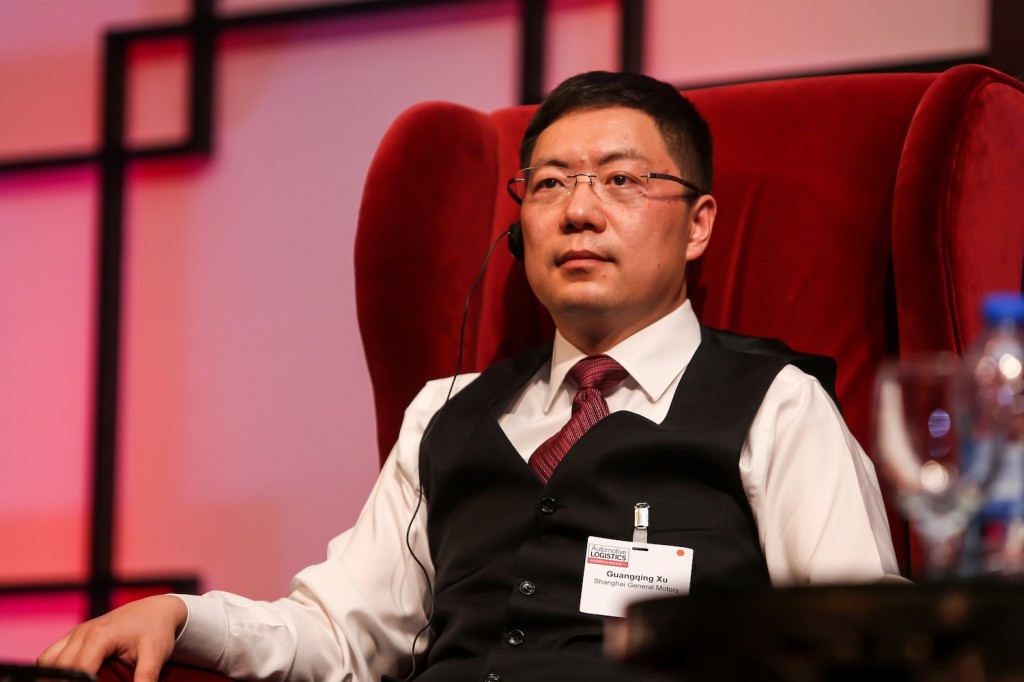
 Xu Guangqing, Shanghai GM: We’ve been talking about this every year but it depends on the decisions. Once the standards are implemented, it will be a setback and lead to big changes in the industry. It takes a long time to retrofit vehicles.
Xu Guangqing, Shanghai GM: We’ve been talking about this every year but it depends on the decisions. Once the standards are implemented, it will be a setback and lead to big changes in the industry. It takes a long time to retrofit vehicles.During that time, OEMs may not be able to ship all the cars they need, and it will result in a price war, which will lead to lower profit margins. It is likely there will be some bankruptcies too in the automotive and logistics industries. Chinese officials don’t want to see bankruptcies, so will be cautious. How can we mitigate the risk? We can use a combination of waterway and rail shipping, and only use trucks for short distances. Companies are reluctant to see standards implemented because it will have a very large impact on our industry.
How big of an impact will the ‘One Belt, One Road’ initiative have on the automotive industry?
 Ma Zengrong, CFLP: The ‘One Belt, One Road’ strategy has accelerated the pace of China’s logistics industry. With this initiative, some leading automotive companies are already exploring how to go global, whereas in the past they merely focused on exploring their existing customers. ‘One Belt, One Road’ is like a dagger for globalisation... the blade will be sharp and forceful. Many companies trying to go global will need the support of financing, which will also play an important role.
Ma Zengrong, CFLP: The ‘One Belt, One Road’ strategy has accelerated the pace of China’s logistics industry. With this initiative, some leading automotive companies are already exploring how to go global, whereas in the past they merely focused on exploring their existing customers. ‘One Belt, One Road’ is like a dagger for globalisation... the blade will be sharp and forceful. Many companies trying to go global will need the support of financing, which will also play an important role.
There are around 22 railroads running along the Euro-Asia railway, so eventually there will be comprehensive coverage of China and Europe, whereas the maritime Silk Road covers less ground.


What is one major thing that will help make the automotive logistics industry in China go from big to strong?
 Jack Huang, Magna: We want a more efficient way to ship from point A to point B to satisfy customers. That’s why we are here.
Jack Huang, Magna: We want a more efficient way to ship from point A to point B to satisfy customers. That’s why we are here. Xu Guangqing, Shanghai GM: I would always choose strong, rather than big. Being big in China is difficult. If you don’t have connections with the government, you can’t be big. But you can be strong. You can be strong as long as you know your core competence. Automotive logistics companies are building up their networks and working on ways to be strong. If you’re moving into a niche market where no one has really been before, you can be strong.
Xu Guangqing, Shanghai GM: I would always choose strong, rather than big. Being big in China is difficult. If you don’t have connections with the government, you can’t be big. But you can be strong. You can be strong as long as you know your core competence. Automotive logistics companies are building up their networks and working on ways to be strong. If you’re moving into a niche market where no one has really been before, you can be strong.
 Ma Zengrong, CFLP: Big and strong are connected. China is really big, but currently we’re all over the place with few regulations. In the past we were a centralised, planned economy, and the model that worked in the past would not work today. Chinese people are very industrious, they are eager to learn, hard-working, smart, down-to-earth, and pay attention. So first of all we need to be attuned to the market changes, and be innovative.
Ma Zengrong, CFLP: Big and strong are connected. China is really big, but currently we’re all over the place with few regulations. In the past we were a centralised, planned economy, and the model that worked in the past would not work today. Chinese people are very industrious, they are eager to learn, hard-working, smart, down-to-earth, and pay attention. So first of all we need to be attuned to the market changes, and be innovative.
We also need to encourage the development of e-commerce. We would be able to sidestep the road well travelled by the West, piggyback on the previous experience of other countries, and grow further.
What will the domestic market look like in 2020?
 Ma Zengrong, CFLP - We have around 150m car owners among a population of 1.3-1.4 billion people. Car ownership is around 10%. As it is low, it means a great opportunity for all of us. I’m not sure it will grow as fast as in the past, but the market potential is there. I’m optimistic about growth in the next few years. I don’t think it would be difficult to hit 30m units output per year by 2020. Automotive logistics companies need to look at growth. Energy is not a big problem in China either, so even with a rise in EVs, it is not likely that traditional internal combustion engine cars will diminish.
Ma Zengrong, CFLP - We have around 150m car owners among a population of 1.3-1.4 billion people. Car ownership is around 10%. As it is low, it means a great opportunity for all of us. I’m not sure it will grow as fast as in the past, but the market potential is there. I’m optimistic about growth in the next few years. I don’t think it would be difficult to hit 30m units output per year by 2020. Automotive logistics companies need to look at growth. Energy is not a big problem in China either, so even with a rise in EVs, it is not likely that traditional internal combustion engine cars will diminish.
Do you see more joint ventures exporting from China in the future?
 Xu Guangqing, Shanghai GM: Whether JV companies can begin to export, that is a sensitive question. SAIC, which 50% of SGM, exports quite a large number of cars and components overall, although don’t compete with Great Wall in some areas. As a JV there are restrictions. Our market agreement has already determined how cars manufactured by JVs are distributed, and FAW and other OEMs would face similar restrictions to us. Of course we try to export cars – built in China means good value, and still reasonably good quality. In the future, vehicles made in China by JV companies could be exported, and there will be cost advantages that foreign partners would have to recognise as well. I don’t think they would stand in the way of cars being exported to other countries.
Xu Guangqing, Shanghai GM: Whether JV companies can begin to export, that is a sensitive question. SAIC, which 50% of SGM, exports quite a large number of cars and components overall, although don’t compete with Great Wall in some areas. As a JV there are restrictions. Our market agreement has already determined how cars manufactured by JVs are distributed, and FAW and other OEMs would face similar restrictions to us. Of course we try to export cars – built in China means good value, and still reasonably good quality. In the future, vehicles made in China by JV companies could be exported, and there will be cost advantages that foreign partners would have to recognise as well. I don’t think they would stand in the way of cars being exported to other countries.
For more on the Automotive Logistics China Conference including the full report, click here.
To see video recordings of some of the event's main sessions, click here.






